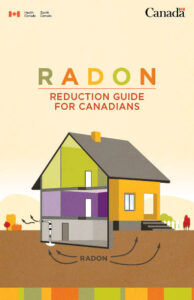Radon is a radioactive gas produced when the uranium in rock and soil breaks down. It’s natural for radon gas to be released into the air outside but radon gas can be dangerous if it’s released and trapped in a closed space, such as your home.
How radon gas can get into your home
Radon gas can move from soil into homes and other buildings through cracks in the walls or floor of foundations. It can also get in through gaps around service pipes, window casements, floor drains, sumps and other openings.
The dangers of radon gas
If the air in your home has high levels of radon gas, and you continue to breathe this air over a long period of time, it can put you at risk for lung cancer. If you also use tobacco, the risk for lung cancer is even higher. Lung cancer is rare in children but the effects of breathing in something like radon gas add up over time. Keeping kids safe from radon gas can help lower their risk over their lifetime.
How to know the radon levels in your home
You can’t see, taste or smell radon. The only way to know the level of radon in a building is to test for it. Do-it-yourself test kits are available at most hardware and home improvement stores and online. To test for radon, you place a small detector in your home for three months. Radon test kits come with instructions on how to set up the test and get your results. Testing can also be done by a certified radon measurement professional.
Safe radon levels
Radon levels in the air are measured in Becquerels per cubic metre. According to Health Canada’s guideline, the radon gas level inside your home should not be higher than 200 Becquerels per cubic metre (200 Bq/m3). The lower the level is, the better.
What to do if you have high levels of radon in your home
If the levels are between 200 and 600 Bq/m3, Health Canada recommends taking action within two years to lower the radon levels. If the levels are 600 Bq/m3 or higher, they should be lowered within a year.
Health Canada recommends hiring a certified professional to help you fix a radon problem. Look for a professional certified by the Canadian National Radon Proficiency Program (C-NRPP). Ways to lower radon levels in a building include:
- Installing a radon mitigation system
- Sealing up cracks and gaps in the foundation
- Increasing ventilation
